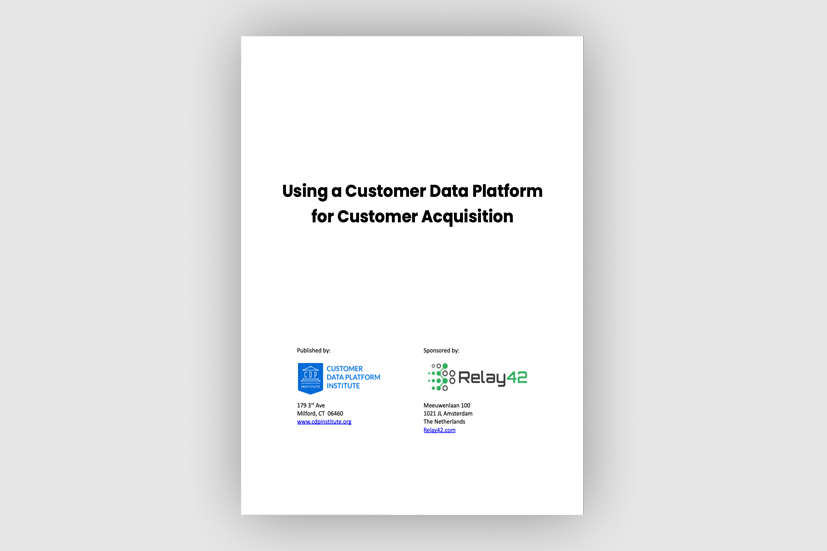5 Ways a CDP Delivers Improved Results for Email Marketing
by Anthony Botibol on 10.6.2024

Email marketing is still a go-to channel for the majority of B2C marketers to engage with their customers and deliver revenue. In 2024, 75.4% of consumers chose the email inbox as a preferred channel for promotional messages.
Plenty of research backs up the efficacy and value of email marketing.
It is expected that email marketing revenue worldwide will quadruple in the next 8 years. Plus, 4.24% of website visitors from email campaigns go on to convert versus just 2.49% from search engines, and 0.59% from social media.

While email marketing is clearly here to stay, in many cases, it is far from an optimized channel. Email marketing solutions have a variety of limitations that can be easily addressed by integrating it with a Customer Data Platform (CDP)
Some common issues that relate to email marketing include:
- Audience Segmentation
- Data Accuracy
- Personalization
- Cross-Channel Orchestration
- Attribution, Analytics, and Insights

1. Audience Segmentation
Email marketing solutions tend to rely on static lists and basic segmentation capabilities that are restricted by its data model. Generally, that data is restricted to demographic information, email open or click behaviors.
To add audience sophistication, marketers will create custom fields and/or import segment information derived from other channels. This creates bottlenecks in campaign delivery, or in many cases where gathering that data from other systems can be too difficult internally to manage, the end result is sub-optimal.
- How to resolve audience segmentation limitations with an integrated CDP -
At its core, a CDP creates unified customer profiles using the entire breadth of data from all your internal systems and solutions in the business.
When integrated into your email marketing platform, it can provide thousands of additional segmentation filters; using real-time data to make emails more relevant.
The CDP effectively replaces any need for internal processes to ETL (Extract, Transform & Load) data from other systems into the email solution:
- Browsing behavior on the website
- Recent intent from programmatic advertising
- AI propensity models
- Call center interactions
- VOC survey responses
- Social engagements
- Purchase history
- Loyalty points
- …and more can be used to create better segments that reflect what an individual customer is more likely to find relevant.
2. Data Accuracy
The data that resides in the email platform is always at risk of being outdated or inaccurate, which will also lead to suboptimal email programs.
In the example whereby internal processes are in place to ETL data from one platform to your email tool, that data is only as up-to-date as the moment it’s imported. Agreed times and processes to refresh that data can be deployed to ensure that’s not the case but is therefore an inefficiency that can be plugged with an investment in a CDP.
- How to resolve data accuracy issues in email programs with an integrated CDP -
A CDP can facilitate a continuous update and cleansing of customer data to ensure the data being used for email marketing efforts is reliable at all times.
Furthermore, RealCDP-certified solutions will use multi-key identity resolution to ensure that separate email addresses can be identified as one individual, removing any chance of CPM cost wastage or multiple conflicting messages being sent to one person.
Worse still, when a customer has opted out from one email address, they will not be happy if emails continue to come to their secondary email address.
The majority of email marketing solutions, marketing clouds, and even CDPs born from email marketing origins will tend to duplicate audiences using an email address as the sole identifier of a customer.
However, when a customer has entered your systems multiple times using a variety of email addresses, the CDP will resolve all email addresses to one unified customer profile, along with the associated opt-ins.
Even this small CDP capability can have dramatic impacts on enterprise brands to enable customer-centric decisions. For example, when a customer opts out from one email address, the CDP can then determine whether you suppress the customer from emails entirely, re-prioritize another email that is still opted in and actively engaged, or even trigger a polite email asking if they want to maintain their subscription with their other emails or not.
Without understanding if the consumer wants to fully opt-out across all their logged emails, or is just undertaking some life admin to clean up their inbox, this is a small process that can be mapped out in the CDP towards a more customer-centric approach to email list growth and maintenance, while showing to the customer you care about their wants and desires.
3. Personalization
Highly linked to segmentation, email marketers need more data than what currently exists in their email marketing solution. This is a must to power the personalized offer or experience to a segment or individual.
1-to-1 marketing has always been the ambition of marketers. While an email automation solution can provide basic demographic data – and generally some purchase history through integrations – the best that marketers can hope to achieve is some transactional RFM (Recency, Frequency, Monetary) segments.
- How to improve email personalization with enriched customer profiles from a CDP -
While a CDP already enables better segmentation of email campaign audiences, it also enables an email marketer to personalize a specific message to an individual customer.
A good example is a ‘Hibernating’ RFM segment which scores low for purchase recency and frequency; and therefore needs a specific strategy to improve its value to the business.
Firstly, it’s important for the marketer to decide if an email is even the right channel to engage with these subscribers on the basis that the desired outcome might be more likely via an app message or paid social ad (which of course the email solution’s own bias is not going to determine for you, but which the integrated CDP will.)
Secondly, a CDP with all the purchase history, historical and latest cross-channel behaviors, preferences, and AI predictions will enable each individual email to be tailored to the most relevant offer or message that would increase engagement, purchase, or achieve the desired campaign objectives.
Finally, while CDPs help improve segmentation and targeting, they can also elevate marketers towards their 1-to-1 personalization ambitions, too.
4. Cross-Channel Orchestration
Another historical limitation of email solutions is the ability to connect email campaigns and experiences with other paid, direct, and offline channels to create cross-channel consistency.
Ultimately, when a customer interacts in a mobile app, website, or perhaps via a call center, marketers want to leverage those interactions to improve the relevancy of their email programs. They also want to ensure that the email-to-web experience is seamless.
If a recent customer satisfaction survey response indicates that a customer is unhappy with their last purchase, promotional email campaigns need to be halted for that individual until there is a signal that their issues have been resolved. Similarly, where a purchase has been abandoned on the website, a basket recovery email might be the best way to bring them back and complete their purchase.
Multichannel Marketing Hubs (some offering lightweight CDP capabilities too) now exist to join your direct channels to coordinate a single campaign across a variety of channels.
However, the underlying technology for these additional channels is usually achieved through a strategy that the SaaS industry refers to as a ‘buy, build or integrate’ decision.
This is a decision that every martech vendor considers when deciding what goes onto its technology roadmap.
Marketing clouds have therefore grown from buying an ESP (Adobe acquired Neolane and Salesforce acquired ExactTarget) to acquiring additional technologies and integrating them together. Smaller Multichannel Marketing Hubs have either started as an email platform and plugged in third-party products (eg. SMS, App push) and worked on creating a seamless interface. Or, others started as a mobile app marketing platform and added email at a later stage.
There is even the choice to buy a CDP with a native email channel – usually by integrating a third-party email-sending engine and a creative builder into the UI. Ultimately, there is now a lot of choice for multi-channel direct marketing solutions where the capabilities of each individual channel may be less than a dedicated messaging solution being used today.
P.S. A third-party email designer and sending engine integrated into a CDP will unlikely give you the full capabilities, expertise, or functionality of an established, 20-year-old ESP vendor!
- How a CDP enables better cross-channel orchestration -
A CDP is not necessarily the only tool to enable you to have better cross-channel orchestration. After all, CDPs come with varied capabilities!
There are ‘Data CDPs as defined by the CDP Institute, which serve to create unified customer profiles to segment and send to your marketing channels, including the email channel. However, they often fail to provide a visual workflow for planning out a customer journey or automation of multiple channels in an interface for marketers to use.
Most 'composable CDP solutions fall into this category, too.
There are, however, the CDP Institute’s ‘Campaign CDP’ cohort, which are CDP solutions that provide connectivity to your existing marketing channels as well as a Journey Orchestration canvas for marketers to visually plan and execute multi-channel and omnichannel experiences.
These can go beyond direct marketing channels too by including paid media activation in the same workflows, segmentation, and personalization.
Then, there are ‘Delivery CDPs’ which are mostly born out of history as an email marketing or web personalization channel tool, but have added some additional flexibility of data and channels over time and are overlapping technologies with Marketing Clouds and Multichannel Marketing Hubs.
‘Campaign CDPs’ are best for businesses that want to keep the existing channel tools that already meet their business needs, but see a CDP as the core way to connect those channels with a central decisioning workflow and visual interface to orchestrate them as one.
5. Attribution, Analytics and Insights
Another limitation of email platforms is that the insights and analytics are predominantly (and understandably) focused on email metrics – open rates, click-through rates, opt-outs etc.
However, marketers need better cross-channel intelligence to understand how multiple channels impact conversions and retention, and to fully understand the customer journey. In many cases the email marketing, eCommerce, paid media, and Mobile teams (for example) will have different ways to measure the success of the channels they manage - and if you were to ask all 4 departments the same question you’d likely get 4 different answers!
Having one consistent way to analyze and measure performance ensures that the business can make consistent, fact-driven decisions, and the marketing teams will be more aligned. The email marketing platform is not the place to facilitate this and inevitably leads to attribution conflicts internally. (Last click vs. first click attribution arguments will always happen between direct and performance marketers!)
- How a CDP helps uncover deeper email marketing insights -
A CDP captures the same data points as the email marketing solution but benefits analytics and systems of insight by combining this with the data insights from other channels, too. This can enable the business to run more sophisticated multi-touch attribution models to calculate attributable revenue or success to a multitude of channels and efforts. In turn, this enables more customer-centric decision-making in future campaign planning.
Having led the marketing function for a variety of email, mobile, SMS, and CDP marketing solutions in my career, I have seen firsthand how CDPs enable these channels, email marketing included, to achieve better results. In my time with enterprise email solutions like Adestra and PostUp, we knew that a brand’s newest email subscribers had the highest propensity to convert when their very latest behaviors across your digital channels could drive the personalization of the message with a CDP integration.
A common customer acquisition tactic for brands is to offer 10% off the first purchase by subscribing to marketing emails. However, the marketing teams would always be questioning whether these new customers would have purchased at full RRP anyway and are simply providing their email addresses in order to take advantage of the discount.
Where I’ve seen a CDP has benefitted these welcome programs is where real-time recommendations are AI-generated from the CDP data to provide a relevant upsell offer in that first email.
This bundled upsell offer actually offsets the claimed discount or indeed can increase the total order value. For the ones that don't convert, the next best offers and a series of personalized retargeting ads triggered by the CDP can remind them of an offer and recapture the abandoned cart in the optimal window of high-purchase-intent by the customer.
Conclusion
While these 5 examples of limitations of email marketing tools – and the ways that a CDP can alleviate them – provide some justification of a business case for investing in a CDP, a company does not usually invest in a CDP to simply improve one channel.
A Customer Data Platform should satisfy hundreds, if not thousands, of use cases directly related to revenue, cost-reduction, efficiency improvements, and accuracy of customer intelligence.
Depending on the existing technology stack within the business, the capabilities of the marketing teams, and the reliability of the data (and of course the budget) will determine how you go about improving your email marketing maturity.
One recommendation I would give to any business considering a CDP investment is to think long and hard about your existing email solution and whether integrating it with a CDP is a better idea than replacing your email platform entirely as part of the investment.
In most cases, the former ensures a smoother adoption of CDP-powered email capabilities!
You May Also Like
These Related Stories

Customer Acquisition is Harder Than Ever in 2025. Here’s How the Right CDP Can Help

3 Ways a Customer Data Platform Delivers More Revenue


.png?width=786&height=265&name=Relay42%20Demo%20Banner%20(1).png)